| |
During two weeks we mainly toured the two provinces of Castille (Castilia-La
Mancha and Castilia-Léon), but we also went as far as Asturia and
Cantabria at the north coast. All in all we covered about 2700 kilometres,
an average of 200 kilometers per day. Temperatures in June ranged between
25 °C and 35 °C.
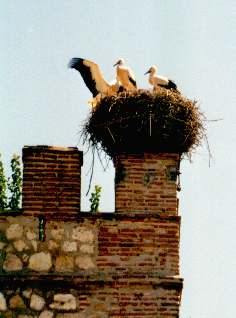 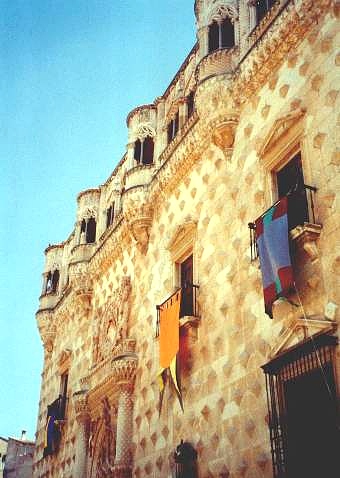 We
arrived at the airport of Madrid at 11:10 a.m., took over our rental car
and drove some
30 minutes to Alcalá
de Henares, a small pretty town, east of Madrid, with an old university,
an archbishop's palace, and
surprisingly many storks nests. The storks weren't even mentioned in my
guidebook, and they shouldn't remain the last ones we saw during this trip.
We left the main road in the direction of Pastrana to travel through some
pretty countryside before we arrived in Guadalajara.
We had planned to spend the night there, but apart from the Palace of the
Dukes of Infantado the town didn't have much of special interest to offer.
Therefore we decided to continue on our way to Cuenca
where we arrived around 6 p.m. We found logdings at the Hotel Alfonso VIII (very nice hotel, 3
stars, only 48 Euros for the double room, breakfast
not included) at the Parque de San Julián in the new part of the city. Cuenca's old town is famous for its Casas
Colgadas, the Hanging Houses.
It's a long climb to the upper part of the town, but well worth it. When
you get to the cathedral square it's not far anymore to the bridge which
offers a great view of the hanging houses. Right across the bridge is the
Parador, one of Spain's state-owned 4-star hotels, housed in an old convent. We
arrived at the airport of Madrid at 11:10 a.m., took over our rental car
and drove some
30 minutes to Alcalá
de Henares, a small pretty town, east of Madrid, with an old university,
an archbishop's palace, and
surprisingly many storks nests. The storks weren't even mentioned in my
guidebook, and they shouldn't remain the last ones we saw during this trip.
We left the main road in the direction of Pastrana to travel through some
pretty countryside before we arrived in Guadalajara.
We had planned to spend the night there, but apart from the Palace of the
Dukes of Infantado the town didn't have much of special interest to offer.
Therefore we decided to continue on our way to Cuenca
where we arrived around 6 p.m. We found logdings at the Hotel Alfonso VIII (very nice hotel, 3
stars, only 48 Euros for the double room, breakfast
not included) at the Parque de San Julián in the new part of the city. Cuenca's old town is famous for its Casas
Colgadas, the Hanging Houses.
It's a long climb to the upper part of the town, but well worth it. When
you get to the cathedral square it's not far anymore to the bridge which
offers a great view of the hanging houses. Right across the bridge is the
Parador, one of Spain's state-owned 4-star hotels, housed in an old convent.
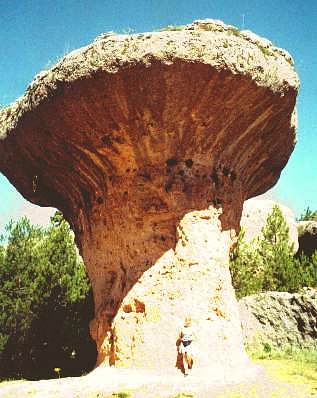 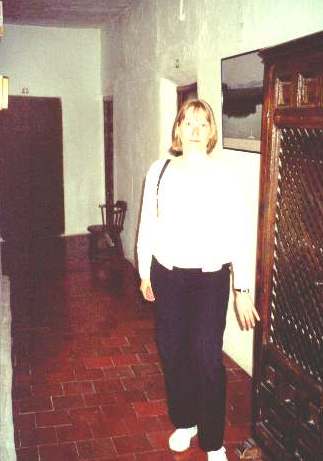 The
following day, 14th June, we checked out of the hotel and drove to the
Enchanted City,
about 30 kilometers east of Cuenca. The Ciudad Encantada is one of Spain's
most spectacular landscapes and consists of curiously shaped rocks formed
through erosion. There is an entrance fee of 1.20 Euros, but it's a nice
walk through a pretty countryside. On our way there we were stopped by
the police (Guardia Civil), but as all our papers were okay, we were allowed
to drive on. We then went to the source (nacimiento) of the Cuervo river,
which was another nice, short walk. As we had to pass by Cuenca anyway
on our way back and as it was too far to drive to the next place on our
route, which seemed to be likely to offer some kind of accommodation, we
decided to spend another night in Cuenca. This time, however, we checked
into a hotel in the old part of town, which saved us the long climb up
the hill! The Hostal Posada de San José (2 stars, 29 Euros) occupies
a renovated historic building. Nothing posh but neat. The
following day, 14th June, we checked out of the hotel and drove to the
Enchanted City,
about 30 kilometers east of Cuenca. The Ciudad Encantada is one of Spain's
most spectacular landscapes and consists of curiously shaped rocks formed
through erosion. There is an entrance fee of 1.20 Euros, but it's a nice
walk through a pretty countryside. On our way there we were stopped by
the police (Guardia Civil), but as all our papers were okay, we were allowed
to drive on. We then went to the source (nacimiento) of the Cuervo river,
which was another nice, short walk. As we had to pass by Cuenca anyway
on our way back and as it was too far to drive to the next place on our
route, which seemed to be likely to offer some kind of accommodation, we
decided to spend another night in Cuenca. This time, however, we checked
into a hotel in the old part of town, which saved us the long climb up
the hill! The Hostal Posada de San José (2 stars, 29 Euros) occupies
a renovated historic building. Nothing posh but neat.
On Friday, 15th June, we travelled through the
flat, dry La
Mancha region, which is Don Quijote country. At first we visited Belmonte castle, where 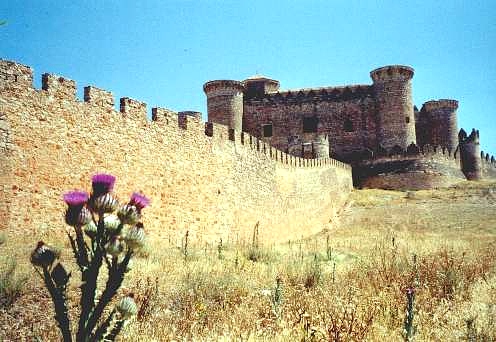 the first part of the "El Cid" movies was shot, then the
windmills of Mota del Cuervo and Campo de Criptana,
which are so typical for this region. Afterwards we went to El Toboso where
the house of Dulcinea, Don Quijote's beloved, is located and can be visited.
In Argamasilla de Alba we saw the prison where Cervantes, the author of
the famous Don Quijote novel, spent some time behind bars. But as it was
the hour of siesta, which is typically between 2 and 5 p.m., it was closed,
so we saw it only from the outside. At the town entrance was a sign with
the first sentence of the novel "En un lugar en la Mancha..." with the
silhouette of Don Quijote on his old horse. As Don Quijote in the novel
didn't want to remember which village he was from, all villages in this
region can claim that they are the place! We spent the night in the rather
modern Ciudad Real at the Tryp Almanzor Hotel (2 stars, 61 Euros including
breakfast and parking). In my opinion the latter part of our trip that
day after Campo de Criptana wasn't really worth driving the long distance
as there wasn't much to see.
the first part of the "El Cid" movies was shot, then the
windmills of Mota del Cuervo and Campo de Criptana,
which are so typical for this region. Afterwards we went to El Toboso where
the house of Dulcinea, Don Quijote's beloved, is located and can be visited.
In Argamasilla de Alba we saw the prison where Cervantes, the author of
the famous Don Quijote novel, spent some time behind bars. But as it was
the hour of siesta, which is typically between 2 and 5 p.m., it was closed,
so we saw it only from the outside. At the town entrance was a sign with
the first sentence of the novel "En un lugar en la Mancha..." with the
silhouette of Don Quijote on his old horse. As Don Quijote in the novel
didn't want to remember which village he was from, all villages in this
region can claim that they are the place! We spent the night in the rather
modern Ciudad Real at the Tryp Almanzor Hotel (2 stars, 61 Euros including
breakfast and parking). In my opinion the latter part of our trip that
day after Campo de Criptana wasn't really worth driving the long distance
as there wasn't much to see.
On Saturday, 16th July, we went to Consuegra, a village with some picturesque
windmills on top of a hill right next to a castle, and then to Ocaña,
which has a Plaza Mayor (main square) from the 18th century. Afterwards
we 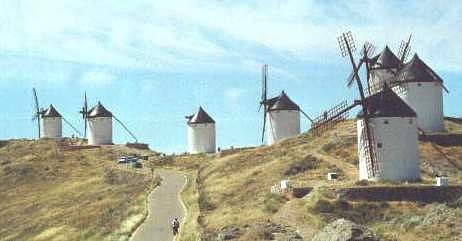 visited the Royal Palace
(Palacio Real) of Aranjuez.
We walked through the gardens and joined a guided tour. There was no access
to the castle without
a tour. Unfortunately, unless we wanted to wait for a couple of hours or
so for the next tour in English, there was only a Spanish tour available.
But at least the guy didn't talk too long and some of the rooms were really
impressive, so it was worth the 4.80 Euros we paid to get in. In the afternoon
we arrived in Toledo, a medieval city of narrow
winding streets perched on a small hill above the river Tajo. It's a beautiful
town with many old buildings, an awesome cathedral, a castle (the Alcázar),
a city wall, two synagogues, but it's also quite touristy. We visited the
Sinagoga Santa Maria La Blanca, now a church but built in the style of
a mosque. The interior is beautiful, but as it's not very large it's not
much you get to see for the 1.20 Euros they charged at the entrance. When
we were there, Toledo was still decorated for the Corpus Christi procession
a couple of days ago. We found lodgings out of town in a beautiful country
house, the obviously recently renovated 2-star Hotel La Almazara (45 Euros
including breakfast, 51 Euros with panaromic view). visited the Royal Palace
(Palacio Real) of Aranjuez.
We walked through the gardens and joined a guided tour. There was no access
to the castle without
a tour. Unfortunately, unless we wanted to wait for a couple of hours or
so for the next tour in English, there was only a Spanish tour available.
But at least the guy didn't talk too long and some of the rooms were really
impressive, so it was worth the 4.80 Euros we paid to get in. In the afternoon
we arrived in Toledo, a medieval city of narrow
winding streets perched on a small hill above the river Tajo. It's a beautiful
town with many old buildings, an awesome cathedral, a castle (the Alcázar),
a city wall, two synagogues, but it's also quite touristy. We visited the
Sinagoga Santa Maria La Blanca, now a church but built in the style of
a mosque. The interior is beautiful, but as it's not very large it's not
much you get to see for the 1.20 Euros they charged at the entrance. When
we were there, Toledo was still decorated for the Corpus Christi procession
a couple of days ago. We found lodgings out of town in a beautiful country
house, the obviously recently renovated 2-star Hotel La Almazara (45 Euros
including breakfast, 51 Euros with panaromic view).
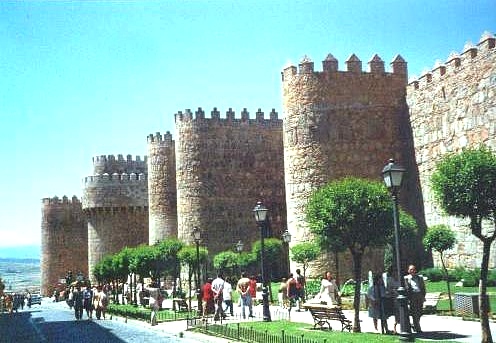 On
Sunday, 17th June, passing by the castles of Maqueda and Escalona, we drove
to the walled city of Ávila, the Spanish
provincial capital situated at the highest altitude (1,130 metres above
sea level), and indeed there was a cold wind in spite of the sunshine.
The old centre of Ávila is completely surrounded by a medieval city
wall. Commenced in 1090, 2.5 kilometers long, it is the most complete and
best preserved in Spain. So it calls itself the best fortified city in
the world. When we got there, all the streets into the old centre were
closed due to a religious procession going on. But we managed to find a
parking space not too far away and started exploring the city. We arrived
at the tourist office before their siesta at 2 p.m. and asked for a hotel map. This made it easy to choose the hotel that suited us best, Hotel Mesón
del Rastro (2 stars, 39 Euros), still in the old centre, but with parking
possibilities nearby. So when the streets were open again, we checked in
with our luggage. The room was not as nice as others we had, but it was
okay and we were right in the town centre. After checking in we visited
Spain's first Gothic cathedral, completed in the 16th century, and strolled
along the top of the city wall, which offered some good views of the towns
many churches, as well as storks flying around and sitting in their nests. On
Sunday, 17th June, passing by the castles of Maqueda and Escalona, we drove
to the walled city of Ávila, the Spanish
provincial capital situated at the highest altitude (1,130 metres above
sea level), and indeed there was a cold wind in spite of the sunshine.
The old centre of Ávila is completely surrounded by a medieval city
wall. Commenced in 1090, 2.5 kilometers long, it is the most complete and
best preserved in Spain. So it calls itself the best fortified city in
the world. When we got there, all the streets into the old centre were
closed due to a religious procession going on. But we managed to find a
parking space not too far away and started exploring the city. We arrived
at the tourist office before their siesta at 2 p.m. and asked for a hotel map. This made it easy to choose the hotel that suited us best, Hotel Mesón
del Rastro (2 stars, 39 Euros), still in the old centre, but with parking
possibilities nearby. So when the streets were open again, we checked in
with our luggage. The room was not as nice as others we had, but it was
okay and we were right in the town centre. After checking in we visited
Spain's first Gothic cathedral, completed in the 16th century, and strolled
along the top of the city wall, which offered some good views of the towns
many churches, as well as storks flying around and sitting in their nests.
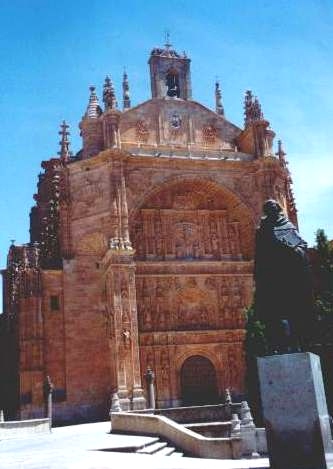 The
following day we travelled to Salamanca and
visited its historic centre: the Plaza Mayor, doubtless the most beautiful
arcaded square in Spain, the two cathedrals, and of course the university.
Salamanca used to be one of Europe's greatest universities. It is the oldest
university in Spain, founded in the early 13th century, and it is still
famous for its summer language school. Salamanca's countless historical
buildings are constructed from sandstone, which seems to turn to gold in
the afternoon sun. The facades of the celebrated Casa de las Conchas (House
of Shells) are decorated with rows of carved scallop shells, symbol of
the pilgrimage to Santiago. We stayed at the modern Hotel Condal (2 stars,
51 Euros) in Plaza de Santa Eulalia, where we payed an additional 9 Euros
for the public car park. But at least we were in walking distance to the
historic centre. The
following day we travelled to Salamanca and
visited its historic centre: the Plaza Mayor, doubtless the most beautiful
arcaded square in Spain, the two cathedrals, and of course the university.
Salamanca used to be one of Europe's greatest universities. It is the oldest
university in Spain, founded in the early 13th century, and it is still
famous for its summer language school. Salamanca's countless historical
buildings are constructed from sandstone, which seems to turn to gold in
the afternoon sun. The facades of the celebrated Casa de las Conchas (House
of Shells) are decorated with rows of carved scallop shells, symbol of
the pilgrimage to Santiago. We stayed at the modern Hotel Condal (2 stars,
51 Euros) in Plaza de Santa Eulalia, where we payed an additional 9 Euros
for the public car park. But at least we were in walking distance to the
historic centre.
On our way to León on Tuesday, 19th June, we stopped in Zamora.
But there wasn't as much to see in Zamora as we thought, nevertheless it
has an old centre with a cathedral, a castle, a Plaza Mayor and a city
wall. Léon, however, was much prettier than
we expected. It has a magnificent Gothic cathedral with beautiful stained-glass
windows, the other great attraction is the church of San Isidoro with the
Royal Pantheon of the early kings of León and Castile (we didn't
visit the latter though), all within remains of Roman and medieval town walls. But León's modern quarters are also quite
attractive. The
Casa de Botines for example is a work of the Catalan architect Gaudí.
We found lodgings right in the centre, Hotel Boccalino (2 stars) in Plaza
San Isidoro, but for a room without private bath and not even a wash basin
51 Euros were quite a high price. At least this time breakfast was included.
On Wednesday, 20th June, we continued north on our way to the Costa
Verde, via Oviedo and Gijón. We were surprised how much smog there
was around those two cities, and we were beginning to believe that it was
a mistake to visit the coast. But when we arrived in the village La Isla
we came across a 2-star hotel at a beautiful, solitary beach. But as we
preferred some more infrastructure, we drove on towards the fishing village
Ribadesella where we checked into the Hotel Don Pepe (3 stars, 51 Euros
without breakfast), right at the beach promenade. Near the village, caves
have been found which are famous for their 20.000 years old wall paintings,
but we didn't go to see them. We had the impression that the village was
more touristy than most places we visited. Prices in the restaurants were
generally more expensive. 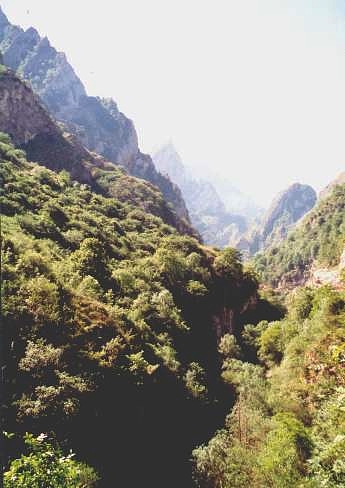
The
following day we explored Spain's first national park Picos
de Europa. This montainous region is the hinterland of the Costa Verde.
The scenery was spectacular with snow-capped mountains, some peaks are
over 2,400 metres high, steep ravines, green alpine meadows, forests of willows,
poplars, yew, oak and beech trees. Occasionally, a bear or a wolf
pass through the park, chamois are more frequent but we saw no wild animals
from the road, which is not surprising I guess. In spite of the altitude
it was a very hot day. So we were looking forward to going back to the
coast where a cool wind was blowing the day before. When we arrived there,
the picturesque fishing village San Vicente de la Barquera which was lying
before us in the sun. The one hotel at the beach was quite expensive, so
we chose a hotel out of town, Hotel Las Calzadas, where we got a small
but nice room with a view and a balcony for only 27 Euros! After checking
in we drove down to the beach. It was around 6 o'clock and people were
sunbathing, some of them even swimming in the cold Atlantic. We walked
along the beach, but all of a sudden the horizon darkened and within minutes the view was obscured by a fairly dense
fog! It seemed like we
were standing right in the middle of a huge cloud. It was eery! So we drove
back into town, which was still partly lying in the sun, climbed up to
the church and the castle and looked out for a not too touristy, not too
expensive restaurant, which we eventually came upon in one of the back streets.
The next morning it was very misty, but we intended to leave the coast anyway. We drove to the
medieval, but rather touristy village Santillana
del Mar, which despite the name is not at the seaside, maybe it used to be. We had to pay for the car park (1.20 Euros), and it seemed only tourists
had to. The weather was still cloudy and cool. But after we crossed the
mountains on our way back inland, the sun was shining again. We arrived
in Burgos and checked into the Hotel Norte y
Londres (2 stars, 58 Euros), a beautiful old building, right in the centre.
This time we were lucky and managed to find a free parking space nearby!
As it was very hot, we had our siesta at the hotel before we ventured out
into the city. Burgos was the home of Spain's national hero El Cid in the
eleventh century. It has a famous Gothic cathedral, one of the greatest
in Spain, and we climbed up the castle hill, which offers a fine view over
the city and its surrounding countryside. The castle itself is a ruin.
On Saturday, 23rd June, we travelled to Valladolid.
This was the first time that we had trouble finding a hotel right away.
Only the third place we tried still had vacancies. This was the Hostal
Paris (2 stars, 55 Euros), just a few steps from the Plaza Mayor. We left
the car at the Plaza Mayor car park (12 Euros). The hotel was very nice,
but we spent a horrible night. Our room went out to a pedestrian area and
as it was a Saturday night, people were sitting at a bar downstairs until
at least 4 a.m. in the morning! Even with closed windows we could hear
almost every word spoken!! So we hardly slept at all, and at 9 a.m. on
Sunday morning, some noisy cleaning machine was rattling through the street
to wake us up again! Valladolid, which used to be Spain's capital several
times in history, has some interesting old buildings, among them the Church
of San Pablo with a beautiful facade, Pimentel Palace with an angled corner
window as an architectural highlight, and the unfinished cathedral. But
it doesn't really have a historic centre, wherefore it has a rather modern
aspect on the whole.
On the Sunday we continued on our way back to Madrid and visited the pretty
castle of Coca. We checked into the Hotel Coregidor
(2 stars, 57 Euros) at Segovia for two nights.
This is a nice, modern hotel just a short walk from the historic centre
and the Roman acqueduct. I really liked Segovia. It has a pretty historic
centre with a picturesque 12th century castle (well worth a visit) towering
above the town, a beautiful Gothic cathedral dating from the 16th century
and of course its acqueduct from the 1st century B.C., which is an uncommon
and impressive view. I can recommend the Taberna of the Hotel Ayala Berganza
for a good, inexpensive dinner (menú del día).
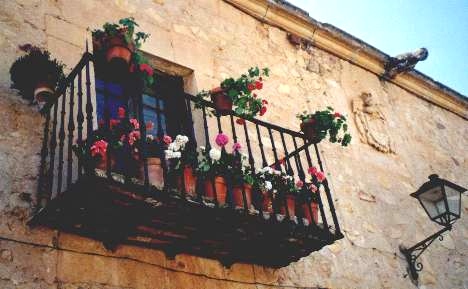 On
25th June we made a trip to the Spanish royal summer residence and world-famous
gardens of La Granja. The historic palace
and spacious gardens were built in French style after the model of Versailles
in Paris, and were completed in 1723. As it was a Monday, the palace itself
was closed, but we had mainly come for the gardens. Those were a big disappointment
however, as all the celebrated fountains were one big construction site.
Obviously they are working on an improvement of the watering system. We
then crossed the Guadarrama mountain range and went to Manzanares el Real
with its pretty castle. If you like hiking, check out the Parque Natural
Cuenca Alta del Manzanares. Pedraza de la Sierra is a lovely old village,
lying on top of a hill. The castle of Turégano is only a ruin. On
25th June we made a trip to the Spanish royal summer residence and world-famous
gardens of La Granja. The historic palace
and spacious gardens were built in French style after the model of Versailles
in Paris, and were completed in 1723. As it was a Monday, the palace itself
was closed, but we had mainly come for the gardens. Those were a big disappointment
however, as all the celebrated fountains were one big construction site.
Obviously they are working on an improvement of the watering system. We
then crossed the Guadarrama mountain range and went to Manzanares el Real
with its pretty castle. If you like hiking, check out the Parque Natural
Cuenca Alta del Manzanares. Pedraza de la Sierra is a lovely old village,
lying on top of a hill. The castle of Turégano is only a ruin.
After another night in Segovia we drove on towards Madrid. We stopped
at Valle de los Caídos (Valley of the Fallen), built by dictator
General Franco in the 1940s as a memorial to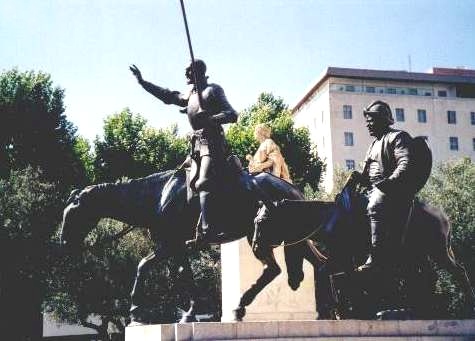 those who died in the Spanish
Civil War. The basilica is a temple of monumental
proportions, built into the mountain and crowned by a huge, 125m-high cross.
It was a peculiar feeling to visit this strange monument, and it was expensive
(4.80 Euros per person). Afterwards we visited the nearby El
Escorial, a vast 16th century monastery-palace built by King Philip II.
They charged 6 Euros per person, but in particular the Royal Pantheon (containing
the tombs of the Spanish royalty up to the present day) and the Sala de
Armas with its huge battle paintings were impressive. Finally we arrived
in Madrid, Spain's rather modern capital, and
checked into the only hotel we had booked in advance during our entire
trip, Hotel Regente (3 stars), in a side street of the Gran Vía,
the city's main street. Its was a good choice as we were right in the city
centre and had a quiet room with air condition, and this at a fair price
of 71 Euros. We also got a special rate at the nearby public parking (9
Euros). After a short siesta we started exploring Madrid, walking to the
Plaza Mayor, the Palacio Real, Plaza de España, Puerta del Sol and
Plaza Santa Ana. The latter has some nice restaurants and tapas bars. those who died in the Spanish
Civil War. The basilica is a temple of monumental
proportions, built into the mountain and crowned by a huge, 125m-high cross.
It was a peculiar feeling to visit this strange monument, and it was expensive
(4.80 Euros per person). Afterwards we visited the nearby El
Escorial, a vast 16th century monastery-palace built by King Philip II.
They charged 6 Euros per person, but in particular the Royal Pantheon (containing
the tombs of the Spanish royalty up to the present day) and the Sala de
Armas with its huge battle paintings were impressive. Finally we arrived
in Madrid, Spain's rather modern capital, and
checked into the only hotel we had booked in advance during our entire
trip, Hotel Regente (3 stars), in a side street of the Gran Vía,
the city's main street. Its was a good choice as we were right in the city
centre and had a quiet room with air condition, and this at a fair price
of 71 Euros. We also got a special rate at the nearby public parking (9
Euros). After a short siesta we started exploring Madrid, walking to the
Plaza Mayor, the Palacio Real, Plaza de España, Puerta del Sol and
Plaza Santa Ana. The latter has some nice restaurants and tapas bars.
On our last day, after visiting the ancient Templo de Debod (Wednesdays
free of charge), an Egyptian temple donated to Spain, we took the cableway
across the Casa de Campo park (return ticket 3.64 Euros). Later we visited
the waxworks at the Museo de Cera (6 Euros) and strolled through the Parque
del Retiro. Madrid was interesting but didn't impress me too much after
all the other places we had visited. And compared to other European capitals
like London, Paris or Rome I don't think it has so many interesting sights
to offer. If you like museums, there's the Prado of course. And it is famous
for its vibrant nightlife.
Our day of departure was Thursday, 28th June, and we had to drive through
the centre of Madrid to get to the airport. The traffic was nightmarish.
We were just glad we arrived at the airport in time, without an accident
and without getting lost!!
To find a hotel we usually went to a tourist office where they handed
out city maps which also showed the hotels, so it was easier to find a
convenient location. All the hotels we stayed in were very nice, clean,
and not too expensive. The only disadvantage sometimes was that the walls
were so thin. Breakfast is usually served but in most cases not included,
and all you usually get is just a roll, toast or biscuit with jam and a
café-au-lait. It's cheaper to go to a bar round the corner and order
the typical churros with coffee or hot chocolate. Don't expect restaurants
to open for dinner before 8 or even 9 in the evening! But at least restaurants
are fairly inexpensive. Most places offer set meals (look out for the menú
del día) for around 7 or 8 Euros.
Reiseroute:
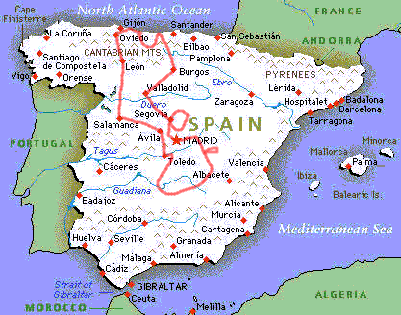
|
|



 We
arrived at the airport of Madrid at 11:10 a.m., took over our rental car
and drove some
30 minutes to
We
arrived at the airport of Madrid at 11:10 a.m., took over our rental car
and drove some
30 minutes to 
 The
following day, 14th June, we checked out of the hotel and drove to the
Enchanted City,
about 30 kilometers east of Cuenca. The Ciudad Encantada is one of Spain's
most spectacular landscapes and consists of curiously shaped rocks formed
through erosion. There is an entrance fee of 1.20 Euros, but it's a nice
walk through a pretty countryside. On our way there we were stopped by
the police (Guardia Civil), but as all our papers were okay, we were allowed
to drive on. We then went to the source (nacimiento) of the Cuervo river,
which was another nice, short walk. As we had to pass by Cuenca anyway
on our way back and as it was too far to drive to the next place on our
route, which seemed to be likely to offer some kind of accommodation, we
decided to spend another night in Cuenca. This time, however, we checked
into a hotel in the old part of town, which saved us the long climb up
the hill! The Hostal Posada de San José (2 stars, 29 Euros) occupies
a renovated historic building. Nothing posh but neat.
The
following day, 14th June, we checked out of the hotel and drove to the
Enchanted City,
about 30 kilometers east of Cuenca. The Ciudad Encantada is one of Spain's
most spectacular landscapes and consists of curiously shaped rocks formed
through erosion. There is an entrance fee of 1.20 Euros, but it's a nice
walk through a pretty countryside. On our way there we were stopped by
the police (Guardia Civil), but as all our papers were okay, we were allowed
to drive on. We then went to the source (nacimiento) of the Cuervo river,
which was another nice, short walk. As we had to pass by Cuenca anyway
on our way back and as it was too far to drive to the next place on our
route, which seemed to be likely to offer some kind of accommodation, we
decided to spend another night in Cuenca. This time, however, we checked
into a hotel in the old part of town, which saved us the long climb up
the hill! The Hostal Posada de San José (2 stars, 29 Euros) occupies
a renovated historic building. Nothing posh but neat. the first part of the "El Cid" movies was shot, then the
windmills of Mota del Cuervo and Campo de Criptana,
which are so typical for this region. Afterwards we went to El Toboso where
the house of Dulcinea, Don Quijote's beloved, is located and can be visited.
In Argamasilla de Alba we saw the prison where Cervantes, the author of
the famous Don Quijote novel, spent some time behind bars. But as it was
the hour of siesta, which is typically between 2 and 5 p.m., it was closed,
so we saw it only from the outside. At the town entrance was a sign with
the first sentence of the novel "En un lugar en la Mancha..." with the
silhouette of Don Quijote on his old horse. As Don Quijote in the novel
didn't want to remember which village he was from, all villages in this
region can claim that they are the place! We spent the night in the rather
modern Ciudad Real at the Tryp Almanzor Hotel (2 stars, 61 Euros including
breakfast and parking). In my opinion the latter part of our trip that
day after Campo de Criptana wasn't really worth driving the long distance
as there wasn't much to see.
the first part of the "El Cid" movies was shot, then the
windmills of Mota del Cuervo and Campo de Criptana,
which are so typical for this region. Afterwards we went to El Toboso where
the house of Dulcinea, Don Quijote's beloved, is located and can be visited.
In Argamasilla de Alba we saw the prison where Cervantes, the author of
the famous Don Quijote novel, spent some time behind bars. But as it was
the hour of siesta, which is typically between 2 and 5 p.m., it was closed,
so we saw it only from the outside. At the town entrance was a sign with
the first sentence of the novel "En un lugar en la Mancha..." with the
silhouette of Don Quijote on his old horse. As Don Quijote in the novel
didn't want to remember which village he was from, all villages in this
region can claim that they are the place! We spent the night in the rather
modern Ciudad Real at the Tryp Almanzor Hotel (2 stars, 61 Euros including
breakfast and parking). In my opinion the latter part of our trip that
day after Campo de Criptana wasn't really worth driving the long distance
as there wasn't much to see. visited the Royal Palace
(Palacio Real) of
visited the Royal Palace
(Palacio Real) of  On
Sunday, 17th June, passing by the castles of Maqueda and Escalona, we drove
to the walled city of
On
Sunday, 17th June, passing by the castles of Maqueda and Escalona, we drove
to the walled city of  The
following day we travelled to
The
following day we travelled to 
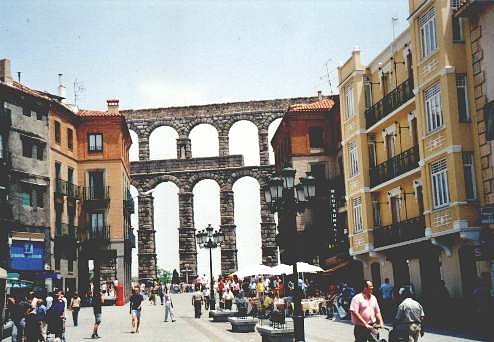
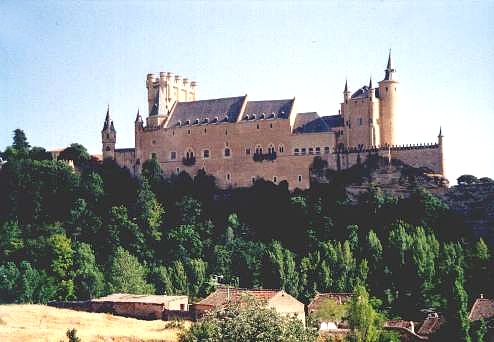
 On
25th June we made a trip to the Spanish royal summer residence and world-famous
gardens of
On
25th June we made a trip to the Spanish royal summer residence and world-famous
gardens of  those who died in the Spanish
Civil War. The basilica is a temple of monumental
proportions, built into the mountain and crowned by a huge, 125m-high cross.
It was a peculiar feeling to visit this strange monument, and it was expensive
(4.80 Euros per person). Afterwards we visited the nearby
those who died in the Spanish
Civil War. The basilica is a temple of monumental
proportions, built into the mountain and crowned by a huge, 125m-high cross.
It was a peculiar feeling to visit this strange monument, and it was expensive
(4.80 Euros per person). Afterwards we visited the nearby 